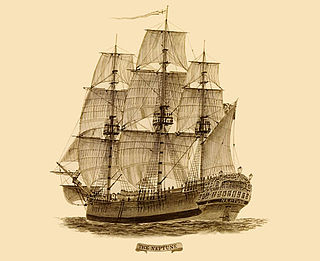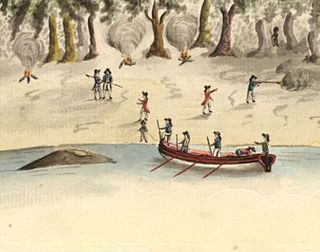
Arthur Phillip was a British Royal Navy officer who served as the first governor of the Colony of New South Wales.

The First Fleet was a fleet of 11 British ships that took the first British colonists and convicts to Australia. It comprised two Royal Navy vessels, three store ships and six convict transports. On 13 May 1787 the fleet under the command of Captain Arthur Phillip, with over 1400 people, left from Portsmouth, England and took a journey of over 24,000 kilometres (15,000 mi) and over 250 days to eventually arrive in Botany Bay, New South Wales, where a penal colony would become the first British settlement in Australia from 20 January 1788.

Lieutenant General Watkin Tench was a British marine officer who is best known for publishing two books describing his experiences in the First Fleet, which established the first European settlement in Australia in 1788. His two accounts, Narrative of the Expedition to Botany Bay and Complete Account of the Settlement at Port Jackson provide an account of the arrival and first four years of the colony.
Prince of Wales was a transport ship in the First Fleet, assigned to transport convicts for the European colonisation of Australia. Accounts differ regarding her origins; she may have been built and launched in 1779 at Sidmouth, or in 1786 on the River Thames. Her First Fleet voyage commenced in 1787, with 47 female convicts aboard, and she arrived at Botany Bay in January 1788. On a difficult return voyage in 1788–1789 she became separated from her convoy and was found drifting helplessly off Rio de Janeiro with her crew incapacitated by scurvy.

Scarborough was a double-decked, three-masted, ship-rigged, copper-sheathed, barque that participated in the First Fleet, assigned to transport convicts for the European colonisation of Australia in 1788. Also, the British East India company (EIC) chartered Scarborough to take a cargo of tea back to Britain after her two voyages transporting convicts. She spent much of her career as a West Indiaman, trading between London and the West Indies, but did perform a third voyage in 1801–02 to Bengal for the EIC. In January 1805 she repelled a French privateer of superior force in a single-ship action, before foundering in April.
Charlotte was an English merchant ship built on the River Thames in 1784 and chartered in 1786 to carry convicts as part of the First Fleet to New South Wales. She returned to Britain from Botany Bay via China, where she picked up a cargo for the British East India Company. Charlotte then spent much of the rest of her career as a West Indiaman in the London-Jamaica trade. She may have been lost off Newfoundland in 1818; in any case, she disappeared from the lists by 1821. Charlotte made an appearance in the movie National Treasure.
Alexander was a merchant ship launched at Hull in 1783 or 1784. She was one of the vessels in the First Fleet, that the British government hired to transport convicts for the European colonisation of Australia in 1788. On her return voyage from Australia the British East India Company permitted her to carry a cargo from Canton back to Britain. Thereafter she traded out of London until 1809, when she is no longer listed.

Surprize was a three-deck merchant vessel launched in 1780 that made five voyages as a packet ship under charter to the British East India Company (EIC). She also participated in the notorious Second Fleet, transporting convicts to Port Jackson. A French frigate captured her in the Bay of Bengal in 1799.

Neptune was a three-decker East Indiaman launched in 1780 at Deptford. She made five voyages for the British East India Company (EIC), the last one transporting convicts to Port Jackson as one of the vessels of the notorious Second Fleet. This voyage resulted in a private suit against the master and chief officer for wrongful death. A fire and explosion in 1796 at Cape Town destroyed Neptune.

Lady Juliana, was launched at Whitby in 1777. She transported convicts in 1789 from England to Australia.

Justinian was launched in 1787 at Rotherhithe as a West Indiaman. Between 1789 and 1791 she served as a storeship, carrying provisions to the convict settlement at New South Wales. From there she sailed to China via Norfolk Island. She returned to England from China.
The history of Australia from 1788 to 1850 covers the early British colonial period of Australia's history. This started with the arrival in 1788 of the First Fleet of British ships at Port Jackson on the lands of the Eora, and the establishment of the penal colony of New South Wales as part of the British Empire. It further covers the European scientific exploration of the continent and the establishment of the other Australian colonies that make up the modern states of Australia.
The following lists events that happened during 1788 in Australia.
William Bryant was a Cornish fisherman and convict who was transported to Australia on the First Fleet. He is remembered for his daring escape from the penal colony with his wife, two small children and seven convicts in the governor's cutter, sailing to Timor in a voyage that would come to rank alongside that of fellow Cornishman William Bligh as one of the most incredible ever made in an open boat.

Commander John Shortland (1739–1803), was a Royal Navy officer, known for being the agent for transports of First Fleet, and for exploring and charting islands in the South Pacific.

The Hawkesbury and Nepean Wars (1794–1816) were a series of conflicts where British forces, including armed settlers and detachments of the British Army in Australia, fought against Indigenous clans inhabiting the Hawkesbury River region and the surrounding areas to the west of Sydney. The wars began in 1794, when the British started to construct farms along the river, some of which were established by soldiers.

There are 20 known contemporary accounts of the First Fleet made by people sailing in the fleet, including journals and letters. The eleven ships of the fleet, carrying over 1,000 convicts, soldiers and seamen, left England on 13 May 1787 and arrived in Botany Bay between 18 and 20 January 1788 before relocating to Port Jackson to establish the first European settlement in Australia, a penal colony which became Sydney.

Arthur Bowes Smyth was a naval surgeon, who traveled on Lady Penrhyn as a part of the First Fleet that established a penal colony in New South Wales. Smyth kept a diary and documented the natural history he encountered in Australia.
George Atkinson, also known as George Atkins, was an English convict sent to Australia aboard a ship of the First Fleet. He was a chimney sweeper.
James Scott was a Sergeant of Marines in the New South Wales Marine Corps and commander of the first quarter guard in New South Wales. He is notable for his journal describing his experiences in the First Fleet, which established the first European settlement in Australia in 1788.













